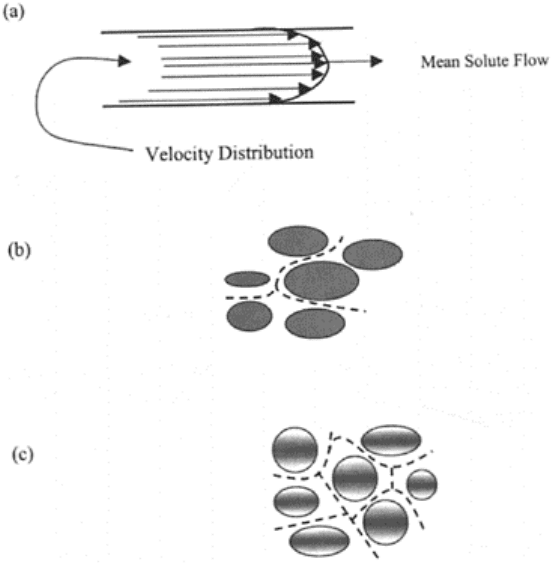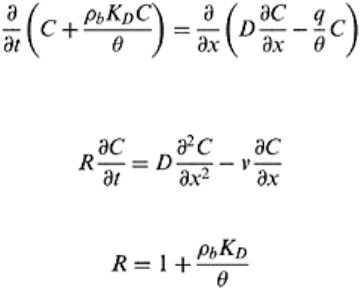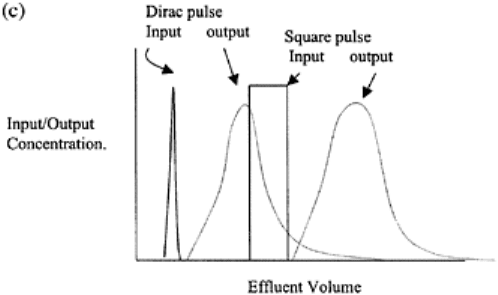Lal R., Shukla M.K. Principles of Soil Physics
Подождите немного. Документ загружается.


calcium carbonate). The anions (e.g., such as nitrate and Br
−
), which are
weakly adsorbed on positively charged sites, are known as nonreactive solutes. The
transport of reactive and nonreactive solutes through soil is affected relative to the
movement of water (Nielsen et al., 1986).
Some solutes are already present in the water-filled pore space of the soil. These
solutes may be present in the soil owing to: (i) mineralization of organic matter, (ii) saline
groundwater intrusion, (iii) fertilizer and/or pesticide application, (iv) atmospheric
deposition, and (v) weathering of mineral. When solute-free water flows through the soil
matrix, the concentration of these preexisting solutes is the highest in those pores
experiencing the lowest water flux. Apart from the preexisting, solutes are also applied
on soil surface (e.g., fertilizer, pesticides, etc.). Basically solute transport within a soil
matrix occurs by two physical processes: diffusion and convective flow. Several simple
and complicated mathematical models have been developed in the past, which can
reproduce the experimental results very well. Most of these models are developed for the
macroscopic scale (Nielsen et al., 1986), although pore scale description is available (e.g.,
Navier–Stokes equation). This chapter describes the transport mechanisms in more detail
and discusses the transport models on a macroscopic scale.
16.2 SOLUTE TRANSPORT PROCESS
The movement of solutes inside the soil matrix is caused by “mass flow” or
“convection.” This type of flow is also called Darcian flow (see Chapter 12). The
velocity at which solutes travel through soil matrix is generally known as “pore water
velocity” and is the ratio of volumetric flow of solute through a unit cross-sectional area
and volumetric moisture content of the soil matrix. In other words, the pore water
velocity is the ratio of Darcian velocity and moisture content. In general, pore water
velocity accounts for the straight-line length of path traversed in the soil in a given time.
In reality, the flow paths are not always straight but are irregular or tortuous. This
property is known as “tortuosity” of soil pores. Solutes do not always flow with water but
sometimes go ahead of it due to the twin process of diffusion and dispersion or exclusion,
lag behind due to adsorption or retardation, or get precipitated or volatilized. The
movement of solute from the higher concentration to the lower concentration gradient is
also known as the process of “diffusion.” This process commonly occurs within gaseous
and liquid phases in the soil matrix due to the random thermal motion, also called
“Brownian movement.” There is another simultaneous process that tries to mix and
eventually even out the concentration gradients known as “hydrodynamic dispersion.”
Diffusion is an active process, whereas dispersion is a passive process. However, in most
practical applications these two solute transport processes are considered additive.
Some chemicals, which are soluble in water and have a nonnegligible vapor phase, can
exist in three different phases in a soil matrix: as a dissolved solute in soil water, as a gas
in soil air, and as an ion absorbed on the soil organic matter or charged clay mineral
surfaces. Therefore, all solute concentration terms are not equal in dimensions and
depend on the concentration in these soil phases and the partitioning of these phases. The
total solute resident concentration (C, g cm
−3
) in a soil matrix can be mathematically
expressed as
Principles of soil physics 434

C=
ρb
C
a
+θC
1
+f
a
Cg
(16.1)
where ρ
b
is the soil bulk density (gcm
−3
), C
a
is adsorbed concentration (g g
−1
), θ is
volumetric soil moisture content (cm
3
cm
−3
), C
1
is dissolved solute concentration (gcm
−3
),
fa is the volumetric air content (cm
3
cm
−3
), and C
g
is gaseous solute concentration
(gcm
−3
). Soil physical parameters (ρ
b
, θ and f
a
) weight the solute concentrations in the
three phases of soil on a volume basis, and convert different reference dimensions to cm
3
of soil. The resident concentration is the volume-averaged concentration in soil, which is
measured by extracting a known volume of soil in water. The resident concentration is
expressed as the mass of solute per unit volume of soil water to make it comparable to
flux-averaged concentration. The flux concentration is the solute concentration in water
flowing through the soil.
16.3 MACROSCOPIC MIXING
Several different mechanisms operating in the porous media during transport of solute are
responsible for the mixing at macroscopic level. Some of these include the following
(Greenkorn, 1983):
1. Molecular diffusion: If the process is stationary or slow moving and the time required
for the solute to move through the porous media is sufficiently long (i.e., for
sufficiently long time scale) molecular diffusion is the primary source of macroscopic
mixing.
2. Tortuosity. The tourtuous flow paths inside the soil profile causes the fluid element to
remain at different distances from the same starting position even when they travel at
the same pore water velocity (ratio of Darcy velocity and soil moisture content).
3. Connectivity of pores: If the pores are not well interconnected or if some of the pores
in the porous media are not accessible to the fluid element flowing through that pore,
they cause macroscopic mixing and dispersion.
4. Hydrodynamic dispersion: The solute element near the wall of pore travels at a
different velocity than the element at the center of pore (Fig. 16.1a). This results in a
velocity gradient inside the pore and solute elements move relative to each other at
different velocity.
5. Immobile zones: The immobile water zones normally causes the fluid element to move
quicker and out in the effluent solution earlier (early breakthrough), and at the same
time, increases the tail of the breakthrough curve mainly due to the slow release of
solute element trapped inside immobile water (see Sec. 16.12).
6. Turbulence: If the size of the pore abruptly changes, the flow inside a pore may
become turbulent and mixing is caused by eddies.
7. Adsorption: When the concentration front looses some ions abruptly as they are
removed from solution by the process known as adsorption, the unsteady state flow
occurs and the concentration profiles becomes flat.
Solute transport 435

FIGURE 16.1 The physical
mechanisms for hydrodynamic
dispersion of solutes through soil
matrix: (a) influence of velocity
distribution within a soil pore; (b)
influence of size of pore, and (c)
influence of microscopic flow
direction.
16.4 FICK’S LAW
There are two Fick’s laws, which describe diffusion of substances in porous media. The
movement of ions from areas of higher concentration to lower concentration is
proportional to the concentration gradient, the cross-sectional area available for diffusion,
and the elapsed time during the solute transport. The net amount of solute crossing a
plane of unit area in unit time is known as the solute flux density (J; gcm
−2
s
−1
), which is
given by Eq. (16.2) known as Fick’s first law (1855) for steady state one-dimensional
solute transport:
Principles of soil physics 436

(16.2)
where D
m
is the ionic or molecular diffusion coefficient of the porous media (cm
2
s
−1
), C
is the solute concentration (gcm
−3
) and x is the distance (cm). The concentration gradient
(∂C/∂x) in Eq. (16.2) is the driving force and the minus sign indicates that solute moves
from areas of higher concentration to lower concentration. The molecular diffusion
coefficient in Eq. (16.2) varies with soil physical and chemical properties of soil and
solute (i.e., soil texture, soil moisture content, solute cocentration, and pH), soil solute
interactions, and temperature. The solute concentration follows a normal, or Gaussian,
distribution and can be described by the mean and variance. The depth of penetration (X
p
)
of a diffusing ion in soil for a given time duration (t) can be estimated by the root mean-
square displacement as follows:
X
p
=(2D
m
t)
1/2
(16.3)
Diffusion in soils is a relatively slow process and operates over small distances, thus
maintaining the electrical neutrality of ions. For transient state condition, Eq. (16.2) is
coupled with the one-dimensional mass conservation equation with no production or
decay taking place during solute transport through soil
(16.4)
Equation (16.4) implies that the net change in solute concentration is as a result of net
change in rate of flow. Combining Eqs. (16.2) and (16.4) and assuming that D
m
is
independent of solute concentration and depth, results in Fick’s second law for one-
dimensional transient solute flow
(16.5)
16.5 TRANSPORT EQUATIONS
When a solute enters a soil matrix (which can be in a soil core, repacked soil column, or
agricultural soil in a field) the initial sharp boundary between the resident and displacing
solute starts diminishing mainly due to the twin processes of diffusion and dispersion.
The transport of a solution through soil matrix consists of three main components:
convection, diffusion, and dispersion, which are briefly described below.
16.5.1 Convection or Mass Transport
Convective or advective transport of a solution inside a soil matrix is known as the
passive movement with flowing soil water. If the transport process has only convective
transport without any diffusion, the water and solute move at the same average flow rate.
Mathematically convective transport (J
m
) can be expressed as
Solute transport 437

J
m
=q
s
C
(16.6)
where J
m
is the flux density for convective or mass transport (ML
−2
T
−1
), q
s
is the
volumetric fluid flux density with dimensions of velocity (LT
−1
), and C is the volume
averaged solute concentration (ML
−3
). The flux density of water can be calculated by the
Darcy equation for a steady state flow of water. The q
s
is also analogous to θ, where v is
the pore water velocity (LT
−1
).
16.5.2 Diffusive Transport
Diffusion is a spontaneous process resulting from the random thermal motion of
dissolved ions and molecules. In general, the diffusion is an active process and diffusive
transport tends to decrease the existing concentration gradients and moves the process
towards homogeneity rather rapidly. Fick’s law defines the diffusive transport and for
one-dimensional steady state transport is given as:
(16.7)
where J
D
is solute flux density for diffusive transport of solute (ML
−2
T
−1
), θ is the
volumetric moisture content (L
3
L
−3
). The diffusion coefficient in soils (D
m
) is slightly
less than the diffusion coefficient in pure water (D
0
) mainly due to the tortuous flow
paths in soils.
D
m
=D
0
θξ
(16.8)
where ξ is the dimensionless tortuosity factor ranging roughly from 0.3 to 0.7 for most
soils.
16.5.3 Dispersive Transport
The soil matrix consists of pores of different shapes, sizes, and orientation. This
heterogeneity of pore structure causes a large deviation of local pore water velocities
inside each individual pore. Consider a one-dimensional flow through a single capillary
tube of constant radius R. According to Poiseuille’s law, the flow rate through each pore
varies proportional to the fourth power of the radius R (Kutilek and Nielsen, 1994).
However, the flow velocity (v) through the tube is a decreasing function of radial
distance (r) from the center of tube. If average velocity is v′ then v=2v′(1−(r
2
/R
2
)), when
r=R, i.e., at the wall of pore v =0, and at r=0, i.e., at the center of pore v=2v′. It is,
therefore, clear that microscopic scale variations of pore water velocity in the soil matrix
are very important and large.
Dispersive transport occurs because of the velocity variations in soil matrix with
respect to average pore water velocity. The velocity variations in a soil matrix is caused
by several factors such as zero velocity at the particle surface, which increases gradually
and is the maximum at the center of pore or at air water interface under unsaturated
Principles of soil physics 438

conditions (Fig. 16.1a). Pore sizes also create velocity gradients with the velocity in
larger pores greater than the velocity in smaller pores (Fig. 16.1b). The other possible
reason is the fluctuation of flow paths of an element of water with respect to the mean
direction of flow (Fig. 16.1c). Macroscopically, dispersion process is similar to the
diffusion process, however, unlike diffusion, it occurs only during water movement. Field
and laboratory experiments have shown that the dispersive transport can be described by
an equation similar to diffusion as follows:
(16.9)
where D
h
is the mechanical dispersion coefficient (Bear, 1972) and is assumed to be a
function of fluid velocity as follows:
D
h
=λv
n
(16.10)
where λ is the dispersivity and exponent “n” is an empirical constant generally assumed
equal to 1.
The mixing or dispersion that occurs along the direction of flow path is called
longitudinal dispersion and that in the direction normal to flow is known as transverse
dispersion. Diffusion is an active process whereas dispersion is passive, in spite of this,
most analysis on solute transport considers both processes to be additive because
macroscopically both processes are similar.
D=D
m
+D
h
(16.11)
where D is the longitudinal hydrodynamic dispersion coefficient (Bear, 1972) or apparent
dispersion coefficient (Nielsen et al., 1972).
Combining Eqs. (16.6), (16.7), (16.9), and (16.11) leads to the following expression
for solute flux, J
s
(16.12)
The equation of continuity states that:
(16.13)
where S
s
is adsorbed concentration (MM
−1
), ρb is the bulk density (ML
−3
), and t is time
(T). Combining Eqs. (16.12) and (16.13) gives the following solute transport equation
(16.14)
It is well known that adsorption and exchange processes are usually nonlinear and also
depend on the competing species in the soil system. Still, one of the most common
approaches to describe the relationship between adsorbed and solution concentrations has
Solute transport 439

been to assume instantaneous adsorption and linearity between C and S of the form
(forcing the constant or intercept to zero)
S
s
=K
D
C
(16.15)
where K
D
is the empirical distribution coefficient. Inserting Eq. (16.15) into Eq. (16.14)
and dividing both sides with θ results in Eq. (16.16):
(16.16)
Assuming that the soil profile is homogeneous and moisture content and flux density are
constant in time and space, Eq. (16.16) reduces to
(16.17)
where R is the retardation factor and is given by
(16.18)
K
D
in Eq. (16.15) can be obtained from the slope of sorbed concentration (MM
−1
) versus
solution concentration (ML
−3
). A zero value of K
D
in Eq. (16.18) reduces R to 1, which
indicates no interactions between solute and soil. A negative value of K
D
makes R less
than one, which indicates anion exclusion or immobile water, which does not contribute
to convective transport. In case of anion exclusion, (1−R) is known as anion exclusion
volume. A positive K
D
results in R>1, which indicates sorption.
16.6 BREAKTHROUGH CURVES
When a fluid (or solute) is passed through a soil matrix containing another liquid in its
pore space, the introduced fluid, which can also be called the displacing liquid or applied
liquid, gradually displaces the preexisting liquid (displaced liquid). Analysis of the
collected effluent from soil matrix at a given depth (or from one end of a repacked soil
column) shows a change in composition of effluent solution with respect to time. If the
displacing and displaced solutions are not mutually soluble, the process is called
“immiscible” displacement (e.g., oil and water). On the other hand, if both solutions are
soluble, the process is called “miscible” displacement (e.g., aqueous solutions). The
graphical representation of the concentration of these solutes with respect to time or
cumulative effluent volume or pore volume is known as “breakthrough curves” (BTC).
Pore volume is the ratio of cumulative effluent volume (cm
3
) at a specified time and total
volumetric moisture content of soil (cm
3
). Pore volume is a nondimensional number and
is zero at time zero.
16.6.1 Solute Input
Principles of soil physics 440
As is evident in Figs. 16.2a–c, BTCs can have different shapes depending upon the solute
application. Figure 16.2a shows a BTC where effluent solute concentration increases and
reaches a maximum and then remains constant thereafter. The y-axis on Fig. 16.2 is the
relative solute concentration (C/C
0
), which is the ratio of concentration of effluent solute
collected at a given time (C) and the concentration of displacing or incoming solution
(C
0
). The BTC in Fig. 16.2a is for a step input of displacing solute or tracer, where
applied solution displaces all the preexisting solution gradually.
Solute transport 441

FIGURE 16.2 Breakthrough curves
with respect to time of effluent arrival,
volume of effluent, and pore volumes,
(a) Chloride application as a step input
through a 10 cm loam soil column
Principles of soil physics 442

(pore water velocity=0.11 cm.h
−1
); (b)
chloride application as a pulse input
through a 10 cm loam soil column
(pore water velocity=0.1 cm.h
−1
); and
(c) schematic for a Dirac and square
pulse input and output. (Modified from
Shukla et al., 2002.)
Therefore, the concentration of applied solution increases whereas that of the preexisting
solution decreases with time. If the application of displacing or applied solution
continues, it attains the maximum concentration equal to C
0
. The ETC in Fig. 16.2b is
obtained from a predetermined volume of the displacing solution followed by the original
or preexisting solution. This type of solute application is known as “pulse” application. A
pulse application can be: (i) a distributed pulse, (ii) a dirac pulse, and (iii) a square pulse.
The concentration of solution applied as a distributed pulse gradually increases, attains a
maximum, and then gradually goes down to zero (Fig. 16.2b). A solute pulse application
for an infmitesimally short period is known as a “dirac pulse” (Fig. 16.2c). When time for
solute pulse application is much smaller than time of leaching, it is called a dirac pulse
input (e.g., single application of highly soluble fertilizer, pesticide, etc.). A square pulse
is a step-up change followed by a step-down change, and the ETC shows a steep rise
followed by steep fall (Fig. 16.2c).
16.6.2 Some Interpretations of Breakthrough Curves
Pore volumes are defined as the ratio of the volume of displacing water (V, water entered
or flowed out at a given time), and the volumetric moisture content of the soil (V/V
0
).
Assuming that the moisture content of soil in a repacked column is 0.5cm
3
cm
−3
(or 50%)
and the total volume of soil column is 100 cm
3
, therefore, volumetric moisture content of
the repacked soil column is 50 cm
3
. Once 50 cm
3
of displacing solution is passed through
the soil column, it corresponds to a pore volume of 1.
Solute transport 443
